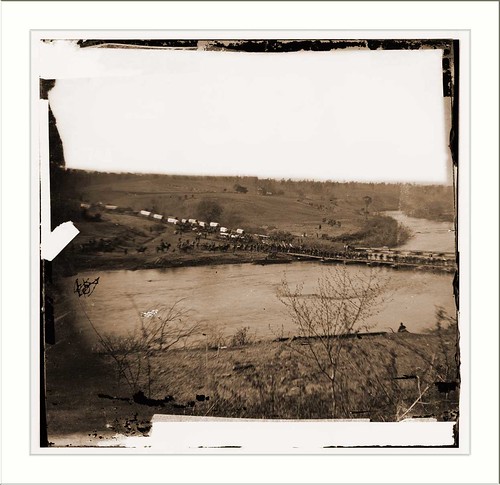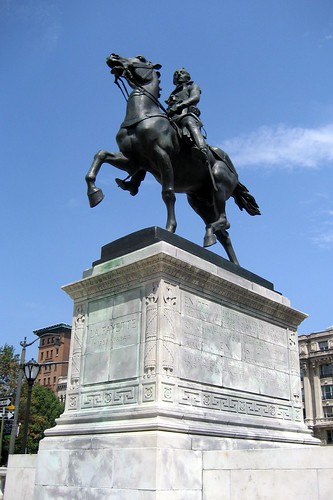 |
| James Ryder Randall |
My. Maryland!
The despot’s heel is on thy shore,
Maryland!
His torch is at thy temple door,
Maryland!
Avenge the patriotic gore
That flecked the streets of Baltimore,
Maryland! My Maryland!
~ ~ o ~ ~
Hark at an exiled son’s appeal,
Maryland!
For life and death, for woe and weal,
Thy peerless chivalry reveal,
And gird thy beauteous limbs with steel,
Maryland! My Maryland!
Thou wilt not cower in the dust,
Maryland!
Thy beaming sword shall never rust,
Maryland!
Remember Carroll’s sacred trust,
And all thy slumberers with the just,
Maryland! My Maryland!
~~ o ~~
Come, ‘tis the red dawn of the day,
Maryland!
Come with thy panoplied array,
Maryland!
With Ringgold’s spirit for the fray,
With Watson’s blood at Monterey,
With fearless Love and dashing May
Maryland! My Maryland!
~~ o ~~
Dear Mother! burst the tyrant chain,
Maryland!
She meets her sisters on the plain -
Sic Semper! ‘Tis the proud refrain
That baffles minions back amain
Maryland!
Arise, in majesty again,
Maryland! My Maryland!
~~ o ~~
Come, for thy shield is bright and strong,
Maryland!
Come, for thy dalliance does thee wrong,
Maryland!
Come to thine own heroic throng.
Stalking with Liberty along,
And chaunt thy dauntless slogan-song,
Maryland! My Maryland!
I see the blush upon thy cheek,
Maryland!
For thou wast ever bravely meek,
Maryland!
But lo! there surges forth a shriek,
From hill to hill, from creek to creek,
Potomac calls to Chesapeake,
Maryland! My Maryland!
Thou wilt not yield the Naudal toll,
Maryland!
Better the fire upon thee role,
Better the shot, the blade, the bowl,
Than crucifixion of the soul,
Maryland! My Maryland!
~~ o ~~
I hear the distant thunder -hum
Maryland!
The Old Line bugle, fife and drum,
Maryland!
She is not dead, nor deaf, nor dumb -
Huzza! She spurns the Northern scum!
She breathes! She burns! She’ll come! She’ll come!
Maryland! My Maryland!
Written at Pointe Coupee, La, 1861. by
James R. Randall
Two weeks before, on April 12 1861, the newly formed confederacy had bombarded Fort Sumter, starting the American Civil War. In response, President Abraham Lincoln ordered 75,000 troops from the northern states to assemble in Washington, D.C. to suppress the rebellion. Baltimore citizens were determined that Northern troops would not make it through their city. And they knew how to put up a fight. The magnificent city of the colonial period had fallen into the grips of thuggery and violence by the 1850s. In fact, Baltimore had such an unruly reputation that in February 1861 Abraham Lincoln went through the city in disguise in the middle of the night on his way to his inauguration.
So when a Massachusetts regiment marched through the city on the way to the capital, it was attacked by a mob, resulting in the first fatalities of the war. All Washington’s connections to the North normally went through Baltimore, but Baltimore citizens had burned all the railroad bridges, cut telephone wires, and stopped all mail en route to the capital city. Cut off from the north and surrounded by a sea of southern states, Washington was left vulnerable for six days. Across the Potomac, southern troops prepared for an attack, and Maryland was threatening to secede at any moment. Maryland straddled the north and the south and both sides fought to win over its population throughout the Civil War. The state never seceded, but around 30,000 citizens enlisted in the Confederate army.
“My Maryland!” serves as Randall’s plea to his home state to secede from the Union and join the Confederacy. The poem refers to the Revolutionary and Mexican-American wars and Maryland military heroes (most of which are now obscure). Randall was a poet, journalist, and professor at Poydras College in Pointe Coupee, Louisiana, and “My Maryland!” won him the title “Poet Laureate of the Lost Cause.” Jennie Carrie set the poem to the tune of “Lauriger Horatius” (O'Tannenbaum), and it became popular across Maryland and the South. CSA bands played the song after they crossed into Maryland during the Maryland Campaign of 1862. Robert E. Lee reportedly ordered troops to sing the song as they entered Frederick, Maryland, where the caroling soldiers were met with a cold audience of Unionists. At least one CSA regimental band played the song as Lee’s troops retreated across the Potomac after the Battle of Antietam.
“My Maryland!” was adopted as the official state song of Maryland on April 29, 1939. Since then, citizens of Maryland have occasionally attempted to replace the song because of the its history with the Confederacy and the fact that the lyrics refer to Lincoln as a “tyrant,” “despot,” and “vandal” and the Union as “Northern scum.” “My Maryland!” remains the official state song.
--Hannah Jarrett '12
Works consulted:
Frank B. Marcotte, Six Days in April: Lincoln and the Union in Peril, New York: Algora Pub., 2005.
http://www.msa.md.gov/msa/mdmanual/01glance/html/symbols/song.html














![Lafayette letter to Francis Huger [recto]](http://farm7.static.flickr.com/6121/5964736558_d2be79fb0a.jpg)
![Lafayette letter to Francis Huger [verso]](http://farm7.static.flickr.com/6125/5964178989_11887075d5.jpg)



